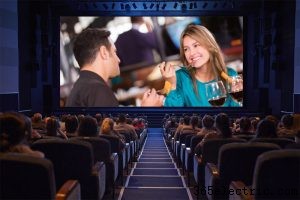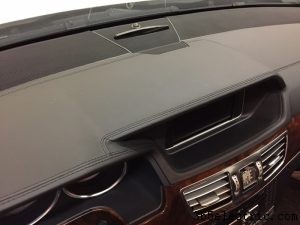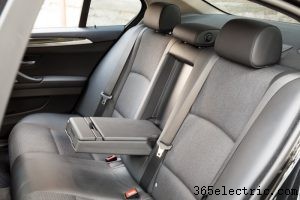
Se você já foi a um cinema, provavelmente já experimentou o que é conhecido como som surround. Há pelo menos cinco faixas de áudio discretas codificadas no filme que você está assistindo, e a maioria também inclui um canal Low-Frequency Effects (LFE). O objetivo desses canais de áudio é permitir que a fonte de cada som seja direcionada para um local específico no teatro, para que todos possam desfrutar de uma experiência realista, não importa onde estejam sentados.
Foi isso que trouxe a introdução do processamento de som surround no mundo automotivo. É relativamente fácil para um projetista de sistema de áudio configurar uma experiência de audição realista a partir de uma única posição de audição usando equalização, ajuste preciso do nível de saída e atraso do sinal. Mesmo quando você se senta muito perto de um alto-falante, o ajuste cuidadoso pode fazer com que a música pareça vir de um conjunto de alto-falantes imaginário em todo o palco sonoro.
Palco da frente
Para os entusiastas de áudio móvel, muitos de nossos esforços no design e no ajuste do sistema vão para a criação do palco principal. Este termo descreve os alto-falantes instalados à nossa frente e suas localizações. Podemos usar o processamento de sinal para ajustar a saída de cada alto-falante para que a música soe como se estivesse vindo do centro do painel, mesmo que você esteja sentado no lado esquerdo do veículo. O problema com esses ajustes é que eles funcionam apenas para um local de assento. O passageiro geralmente sofre com uma resposta de frequência abaixo do ideal e a maior parte da música parece emanar do lado direito do painel. Para o realismo, isso é menos do que o ideal.
Tecnologia de direção de som

A maioria dos cinemas tem alto-falantes dedicados esquerdo, central e direito atrás da tela principal. A inclusão do canal central permite que o produtor de áudio fixe a posição das vozes e efeitos em um local específico em relação à tela. Se alguém estiver sendo entrevistado e estiver centralizado na imagem, sua voz provavelmente será reproduzida apenas pelo alto-falante central. Se eles se movem pela imagem, o nível de sua voz diminui no centro e aumenta em um dos alto-falantes esquerdo ou direito em relação à sua posição. Mesmo se você estiver sentado no lado direito do teatro, vozes e sons são direcionados para um realismo incrível.
Som surround em carros e caminhões

Think about how well the ability to steer sound works in a theater when you are in a less-than-ideal seating position. Now think about your vehicle. You are sitting much closer to the left-side speakers. You will hear sound from them before anything from the right speakers, and those sounds will be louder. Your music will seem to come from the door or left side of the dash.
By including a center channel in the middle of the dash, the system designer can route audio signals that are equal in amplitude in both left and right channels to the center speaker. To improve the accuracy of the system a step further, those signals are also removed from the left and right speakers. The result is a system that reproduces music evenly across the dash from both the left and right seat. Music sounds great from the back seats as well.
Rear and Side Speakers

In our movie theater, the rear or side speakers are primarily used for special effects. A helicopter or plane flying into the scene from behind us is a good example. In modern movie production, that information is hardcoded into the surround channels.
Because we are only listening to two-channel audio (left and right) in our vehicles, there is no opportunity for the music producers to direct specific sounds to rear channels. However, complex signal processors from companies like Bose and Harman do an excellent job of extracting audio information that is suitable for the rear speakers. Sophisticated algorithms can also produce an increased sense of soundstage width in systems with speakers in the rear doors. Rear deck speakers add a sense of ambiance and room size to the performance. How they analyze the relative phase and amplitude of signals within the stereo recording is simply amazing. So, too, are the results of their efforts. Your music can appear to come from spaces beyond the boundaries of your vehicle.
Mix it Up
OK, we admit that the title of this article is click bait. We are talking about upmixers here. An upmixer, by definition, takes a number of audio channels (in our case, two) and turns them into a greater number of channels (usually six). If we feed an upmixer left and right signals, it can generate left, center, right, left rear, right rear and subwoofer output signals. Some upmixers provide eight channels:left, center, right, left side, right side, left rear, right rear and subwoofer. Many OEM systems use these 7.1 systems with great success!
You sold me! Gimme, Gimme, Gimme!

When it comes to the aftermarket, the options for upmixers are limited. Some people have mucked around with using computers or tablets with external sound cards, but the interface is clunky and frustrating. On top of that, you don’t get a radio tuner, there is no backup camera input and you can’t add SiriusXM. Tablets look cool, but they are not ideal for use in vehicles.
The Alpine PXA-H800 processor (and companion RUX-C800 controller) includes Dolby Digital, Dolby Pro Logic II and DTS Digital Surround decoding. This processor will generate a genuine center channel signal with audio information that is removed from the left and right channels.
Audiofrog hasn’t been shy about the fact that they are working on a new signal processor that is specifically designed to create a realistic center channel and surround channels. The solution is called Multiseat Stereo. Unlike most systems that use versions of DTS or Dolby Digital, Audiofrog has partnered with PerfectSurround to create a system that is free from phase artifacts.
Confuso? Don’t be. In a nutshell, PerfectSurround does a better job of steering sound than other processing systems. The results are more realistic and provide better bass focus in the front of the vehicle. There is no firm release date as yet, due to patent applications and all that business stuff, but keep your eyes peeled.
The Future of Great Mobile Audio for Everyone
If you and your co-pilot both love great car audio, then a mobile sound system with a correctly processed center channel is an easy way for both of you to enjoy a realistic performance from any position in the vehicle. If your car or truck came with a surround sound system, visit your local mobile enhancement retailer to find out how they can upgrade it with better speakers, more power and tuning that matches your listening preferences.
If you are designing a new system, then keep an eye out for new processors to arrive on the market. The future of mobile entertainment that sounds realistic for everyone in the vehicle will be based on upmixers.
 Se você já foi a um cinema, provavelmente já experimentou o que é conhecido como som surround. Há pelo menos cinco faixas de áudio discretas codificadas no filme que você está assistindo, e a maioria também inclui um canal Low-Frequency Effects (LFE). O objetivo desses canais de áudio é permitir que a fonte de cada som seja direcionada para um local específico no teatro, para que todos possam desfrutar de uma experiência realista, não importa onde estejam sentados.
Se você já foi a um cinema, provavelmente já experimentou o que é conhecido como som surround. Há pelo menos cinco faixas de áudio discretas codificadas no filme que você está assistindo, e a maioria também inclui um canal Low-Frequency Effects (LFE). O objetivo desses canais de áudio é permitir que a fonte de cada som seja direcionada para um local específico no teatro, para que todos possam desfrutar de uma experiência realista, não importa onde estejam sentados.  A maioria dos cinemas tem alto-falantes dedicados esquerdo, central e direito atrás da tela principal. A inclusão do canal central permite que o produtor de áudio fixe a posição das vozes e efeitos em um local específico em relação à tela. Se alguém estiver sendo entrevistado e estiver centralizado na imagem, sua voz provavelmente será reproduzida apenas pelo alto-falante central. Se eles se movem pela imagem, o nível de sua voz diminui no centro e aumenta em um dos alto-falantes esquerdo ou direito em relação à sua posição. Mesmo se você estiver sentado no lado direito do teatro, vozes e sons são direcionados para um realismo incrível.
A maioria dos cinemas tem alto-falantes dedicados esquerdo, central e direito atrás da tela principal. A inclusão do canal central permite que o produtor de áudio fixe a posição das vozes e efeitos em um local específico em relação à tela. Se alguém estiver sendo entrevistado e estiver centralizado na imagem, sua voz provavelmente será reproduzida apenas pelo alto-falante central. Se eles se movem pela imagem, o nível de sua voz diminui no centro e aumenta em um dos alto-falantes esquerdo ou direito em relação à sua posição. Mesmo se você estiver sentado no lado direito do teatro, vozes e sons são direcionados para um realismo incrível.  Think about how well the ability to steer sound works in a theater when you are in a less-than-ideal seating position. Now think about your vehicle. You are sitting much closer to the left-side speakers. You will hear sound from them before anything from the right speakers, and those sounds will be louder. Your music will seem to come from the door or left side of the dash.
Think about how well the ability to steer sound works in a theater when you are in a less-than-ideal seating position. Now think about your vehicle. You are sitting much closer to the left-side speakers. You will hear sound from them before anything from the right speakers, and those sounds will be louder. Your music will seem to come from the door or left side of the dash.  In our movie theater, the rear or side speakers are primarily used for special effects. A helicopter or plane flying into the scene from behind us is a good example. In modern movie production, that information is hardcoded into the surround channels.
In our movie theater, the rear or side speakers are primarily used for special effects. A helicopter or plane flying into the scene from behind us is a good example. In modern movie production, that information is hardcoded into the surround channels.  When it comes to the aftermarket, the options for upmixers are limited. Some people have mucked around with using computers or tablets with external sound cards, but the interface is clunky and frustrating. On top of that, you don’t get a radio tuner, there is no backup camera input and you can’t add SiriusXM. Tablets look cool, but they are not ideal for use in vehicles.
When it comes to the aftermarket, the options for upmixers are limited. Some people have mucked around with using computers or tablets with external sound cards, but the interface is clunky and frustrating. On top of that, you don’t get a radio tuner, there is no backup camera input and you can’t add SiriusXM. Tablets look cool, but they are not ideal for use in vehicles.